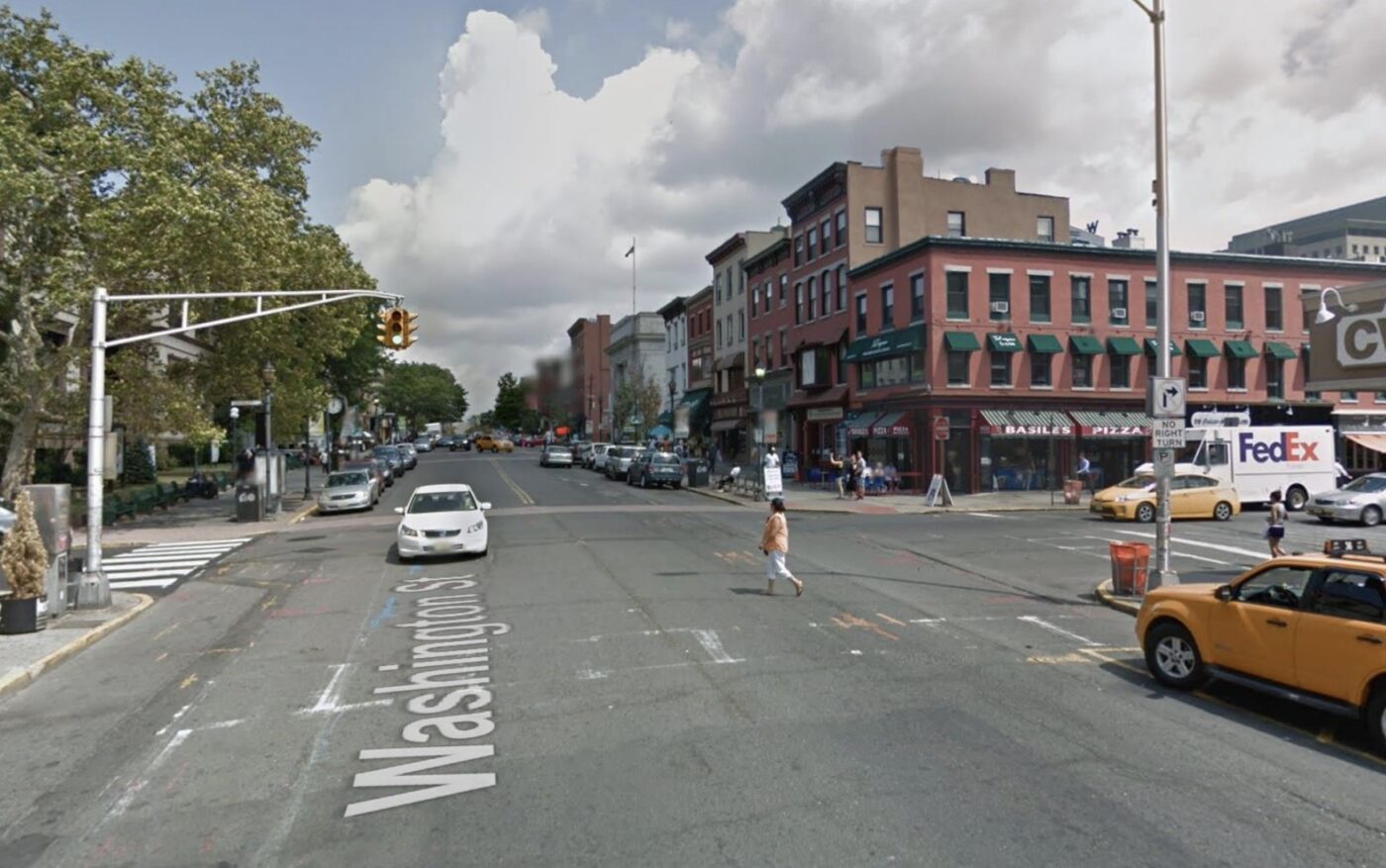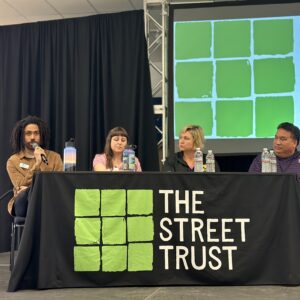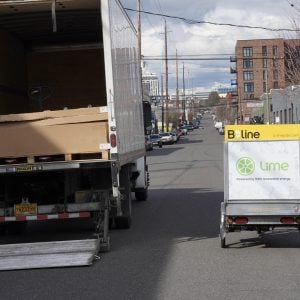

When Ryan Sharp was a planning school student in the late 2000s, he was deeply inspired by Portland. On Tuesday, 13 years after landing a job with the City of Hoboken, he experienced quite a role reversal when he found himself on-stage in Portland with dozens of planners and advocates looking up at him for inspiration.
Coming to Portland, Sharp said at the outset of his keynote at the Oregon Active Transportation Summit Tuesday morning, “Was like a pilgrimage for me in a lot of ways.”
Sharp is Hoboken’s director of transportation and parking and is in demand as a speaker because of one startling statistic: this small city in New Jersey across the Hudson River from Manhattan has not had a fatal traffic crash for six years. At a time when vision zero has become the top transportation goal in hundreds of cities across the country, Hoboken is the only one to actually achieve it.
While Hoboken has very obvious and important differences from Portland — public transit is plentiful and popular, it has only 60,000 residents and is less than two square miles in size — Sharp believes it can have an outsized influence. His invitation to the summit is testament to that belief.
Sharp’s goal with a speech at a conference 2,891 miles away from home was to pay back some of that inspirational momentum to advocates and leaders from Portland and across Oregon who’ve been battered by humbling headlines of record traffic deaths and declining use of transit and bicycles.
The presentation Sharp shared was part pep talk and part recipe for success.
First, he said going six years without a fatal crash is largely thanks to, “A lot of damn good fortune.” “There’s always going to be things outside of our control,” he added, knowing he was speaking to a room full of agency staffers and advocates, “I think we have to acknowledge that and accept that as part of that process so we’re not too hard on ourselves. Because at the end of the day how many deaths have been prevented that we’ll never be able to know about because of the work that you guys all been doing?”
Then it was time to share the nitty-gritty secrets of success.
Hoboken had the fortune (or misfortune) of being able to do a hard reset on its city government in the late aughts. Political scandals and corruption led to a clean sweep of top elected officials and a new mayor came into office in 2009. Vast distrust of government from the public was countered by fresh faces in city hall eager to put the past in the rear view mirror. Transportation got a huge shot in the arm when Dawn Zimmer became mayor. Sharp said she was an active transportation advocate and a daily bike rider.
Zimmer also understood the power of modeling — something we’ve seen almost none of from our local elected officials.
“[Zimmer’s] first act as mayor,” Sharp shared. “Was an executive order that allowed city employees to park their bicycles inside of city hall. So that was a statement of intent.” (In contrast, Portland’s city hall has gone in the opposition direction. After having multiple bike parking corrals in the plaza outside the building for years, that parking was removed in 2018 and was never replaced.)
I learned Tuesday that Hoboken didn’t even have a full-fledged transportation engineering or planning department until 2009, so they could create something from scratch. They began with a bicycle and pedestrian plan in 2010 and went about making small changes on a very small budget. There were no bike lanes in Hoboken at that time, and Sharp said city crews had to teach themselves how to paint bike symbols. “Our [bike marking] stencils were a little bit off… the lines are a little wavy, but whatever we got it done,” Sharp recalled.
The lack of city funds for transportation projects at the outset meant Sharp and his team had to be very efficient and stick to the basics: A few cones in the middle of the street acted as a mini-roundabout; Two plastic delineator wands at a corner to prevent parking and “daylight” the intersection; bike racks in the street to encourage cycling.
They also had to be cognizant of the public pushback against change. “A lot of the things that are in [our bike and pedestrian plan] are things that hadn’t happened in Hoboken before, like creating a citywide bicycle network. So Sharp leaned heavily on pilot projects. “They’ve been devastatingly effective,” he said, in large part because they disarm people who might have concerns:
“You may not believe bike lanes are needed. You may not believe you need to build out curb extensions, to shorten a pedestrian crossing distance or make it easier for people of all ages and abilities to cross the street safely. You may not believe we have the ability to even implement a project like that because of the distrust, and so forth that had been permeating the community for some time. So let’s try it. Let’s see if it works.”






On-street bike parking corrals (plans for which Sharp said he stole directly from Portland), intersection daylighting, a small bike share system, replacing curbside parking with a bike lane — these were all started as pilot projects. And they all turned out to be very popular with the public, a fact that the city knows because they surveyed people about them.
Hoboken’s efforts took a huge leap in 2011 when they began to implement their complete streets policy because it allowed them to institutionalize these pilots and other new approaches. And Sharp explained that it wasn’t just a plan that sat on a shelf and gathered dust. It had real impact because the components of the plan were required in projects. “This was not something that, you know, if we had extra money we would do or look into it, and maybe it’s feasible, maybe not. The goal was to make complete streets components as fundamental as a centerline or an ADA ramp.”
One aspect of Hoboken’s complete streets policy stood way out in my mind: How they approach “pavement management,” a.k.a. how they prioritize paving projects in their capital project budget. Sharp said they “turned that on its head a little bit” by re-orienting the program away from a car-centric approach that prioritizes investments solely on pavement condition. Instead of ranking and scoring streets for repaving investments based on pavement condition and things like traffic volumes (which is how Portland and ODOT and most every other DOT does it), Hoboken expanded the approach to give more weight to non-driving metrics. “If it’s a bike route or a future bike route, it gets a bonus point,” Sharp explained. “Does the street go through a lower income census block? Okay. You get a bonus point. Is it a transit route? Is it adjacent to a park or a senior building? You get a bonus point.”
Sharp also shared a very relevant story about a major project on one of their marquee streets. He and his team at the DOT proposed a $20 million plan to remake Washington Street with curb extensions, safer crossings, narrower driving lanes, and physically protected bike lanes. At the last minute however, city council members didn’t support the protected lanes (because of pushback from business owners worried about parking access); but Sharp didn’t let that stop them.
“We said, okay, that’s fine, we’re going to put in these really bright green bike lanes, then they’re going to attract a lot of people to ride in the street. And we’re going to do the best we can to make it as safe as possible. And if it works, then great. That’s a big victory. If it doesn’t work, well, then we’re going to have a huge new group of supporters and advocates who have experienced the bike lanes first-hand, and the next time Washington Street is up for repaving that support is probably going to be there because there’s going to be an overwhelming amount of people putting pressure on their elected officials to make that change to correct what didn’t happen the first time around.
And that’s already happening. There are already council members that voted against the protected bike lanes just a few years ago, that now publicly come out in support of changing them the next time there’s an opportunity. So these things can happen in phases, you may not always get everything you want the first time you redesign a street… But if we build momentum, and we can play that long game over time, good things can happen.”
Sharp believes in getting wins, but he also plays the “long game.” “Not every community has to be the Michael Jordan of complete streets,” he said, making a basketball reference centered around Tim Duncan, a player known for his humble, basic approach to the game who nonetheless won five championships, “We don’t have to constantly reinvent everything. We just have to keep doing the things that work, well.”
Sharp wrapped up by rubbing salve over the wounded egos in the room that have been battered by negative headlines. “The work you guys are doing has led to everything I just showed you, and now communities are following Hoboken. And so that’s your legacy… You’re still inspiring communities across the country that are a long way from the Pacific Northwest. So I think the future is bright.”









Thanks for reading.
BikePortland has served this community with independent community journalism since 2005. We rely on subscriptions from readers like you to survive. Your financial support is vital in keeping this valuable resource alive and well.
Please subscribe today to strengthen and expand our work.
Basic competence.
Strong commitment.
No mention of VZ.
I wish PBOT could at least commit to keeping crosswalks open! The fact hat they closed a crosswalk that connected a curb extension at a hotel to the riverfront park speaks volumes about PBOT’s commitment to complete streets. (SW Morrison: https://www.google.com/maps/@45.5175227,-122.6726202,3a,60y,190.9h,72.04t/data=!3m6!1e1!3m4!1sWwAgOaBGJqYqWYMox4ecNw!2e0!7i16384!8i8192). For PBOT, a complete street is completely for cars!
PBOT used to plan and design street well. Around 2010, the recession forced layoffs and the bureau never recovered. They have been bikewashing and greenwashing some half=assed design work for the last decade. The bright side of that is all the bikewashing and self promotion appears to have inspired some actual good work in New Jersey.
TLDR: perfection—which we are lousy at, anyway—is the enemy of the good.
Cast the seeds, see where they sprout, and nurture their growth.
How could this happen???
BP commentators (and thousands upon thousands of numtots) assured me that paint on the street is utterly worthless.
I still believe that buffered and/or green bike lanes are the best bang for our buck when it comes to rapidly building out a connected network. (0.3 miles of protected bike lanes or 20 miles of buffered green paint bike lanes?